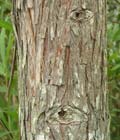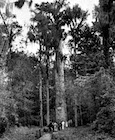
Tree at North Carolina Botanical Garden, Chapel Hill, NC. The tree is near the time of shedding its foliage [C.J. Earle, 2004.10].

Bark on the above tree, approx. 15 cm dbh [C.J. Earle, 2004.10].

Foliage on the above tree, showing the linear cladodes and imbricate foliage for which the variety is named [C.J. Earle, 2004.10].

Photo of the Senator from early in the 20th Century, before a protective fence was built around the tree. Stated size at the time was 17.5 feet (533 cm) diameter and 127 feet (35.7 m) tall [Leon A. Page, n.d.].

Conservation Status

Taxodium distichum var. imbricarium
(Nuttall) Croom 1837
Common names
Pondcypress (Watson 1993).
Taxonomic notes
Syn: Cupressus disticha Linnaeus var. imbricaria Nuttall 1818; Taxodium ascendens Brongniart. The name Taxodium distichum (Linnaeus) Richard var. nutans (Aiton) Sweet has been misapplied to this taxon; the type of this name belongs to var. distichum (F. D. Watson 1985) (Watson 1993). In popular use the variety is often named "imbricatum" rather than "imbricarium," and is sometimes called Taxodium imbricarium (or Taxodium imbricatum) though no species has been described by that name.
Description
Trees to 30 m tall and 200 cm dbh. "Bark brown to light gray, typically somewhat thicker and more deeply furrowed than that of other varieties. Branchlets with leaves not in 2 ranks, mostly ascending vertically. Leaves ca. 3-10 mm, appressed and overlapping, mostly narrowly lanceolate, free portion not contracted or twisted basally. 2n= 22" (Watson 1993). See García Esteban et al. (2004) for a detailed characterization of the wood anatomy.
Distribution and Ecology
USA: North Carolina, South Carolina, Florida, Georgia, Alabama, Mississippi and Louisiana at 0-100 m elevation in blackwater rivers, lake margins, swamps, Carolina Bay lakes, pocosins, and wet, poorly drained, pine flatwoods (Watson 1993). Hardy to Zone 7 (cold hardiness limit between -17.7°C and -12.2°C) (Bannister and Neuner 2001).
This variety has not been assessed by the IUCN and thus has no formal conservation status. Per IUCN criteria, it would likely be assessed as "Least Concern" which is the ranking assigned to T. distichum.
Remarkable Specimens
American Forests (2019) report a "champion" in Lake, Florida that has diameter 198 cm, height 29.0 m, and crown spread 24.5 m. The specimen with greatest known stem volume was the "Senator" (also called the "Sovereign Cypress"), located in Big Tree Park, Longwood, Florida. This tree had a dbh 344 cm, a height of 35.0 m, and an approximate stem volume of 119.4 m 3 (Van Pelt 1998), but it was set on fire by a local resident and burned on January 15-16, 2012 (Huffington Post 2012). This is another in a long list of cases where an extraordinarily large, tall, old, or otherwise significant tree has been destroyed because of its celebrity. The remains of the Senator were made available to Florida artists for use in sculpture; examples [video] are in the collection of the Museum of Seminole County History (OrangeObserver.com 2015).
I have found no reliable data on tree ages. The "Senator" mentioned above was popularly described as 3,500 years old but there was no data to support this speculative age, which has been variously described as the determination of "experts" in the 1930s or determined by "increment borer" which is not logical given that the tree was hollow. Moreover, the photo shown at right included a handwritten note describing the 3,500 year age, though the photo seems to have been taken prior to the invention of the increment borer; thus the "experts" had no tools with which to develop an age estimate. However, since specimens of subsp. distichum have been shown to attain ages of ca. 2,000 years, comparable ages are plausible for subsp. imbricarium.
Ethnobotany
As shown in the "Taxonomic Notes" section of Taxodium, the two varieties of T. distichum are shown by morphological, molecular, and ecological lines of evidence to indeed be varieties, rather than subspecies, with far too much genetic mixing and overlap in characters to be regarded as distinct species. The persistent popular recognition of "pondcypress" as a distinct species is a cultural phenomenon that persists despite abundant biological evidence to the contrary. It is a popular tree, almost emblematic of the deep southern U.S., most abundant in the states of Mississippi, Alabama, Florida, Georgia, and the Carolinas. Within that range, large and historic specimens are revered, and it is an exceedingly popular tree in horticulture.
Observations
The "dwarf cypress grove" in Florida's "Tate's Hell State Forest" is ecologically interesting; due to high water table and very poor soils, the pondcypress here are only 15 feet tall but up to several hundred years old. A trailhead and boardwalk make for easy access. The trailhead is located at 29.835818°N,84.793065°W.
Remarks
A study of regeneration after fire (Cool and Ewel 1992) has found that "[a]lthough basal sprout reproduction by cypress was common in the burned swamps, no seedlings were found. This suggests that other factors, such as hydroperiod, are important in regeneration of cypress swamps."
Citations
American Forests 2019. Pondcypress (Taxodium ascendens). https://www.americanforests.org/big-trees/pondcypress-taxodium-ascendens-3/, accessed 2019.04.13.
Cool, S. and K. C. Ewel. 1992. Regeneration in burned cypress swamps. Florida Science 55(1):62-65.
Croom, H. B. 1837. A Catalogue of the Plants of New Bern, North Carolina..., Ed. 2. New York (no. 3048).
Huffington Post. 2012.03.04. The Senator: Sara Barnes Charged With Setting Fire That Destroyed 3,500-Year-Old Florida Cypress Tree. http://www.huffingtonpost.com/2012/02/28/the-senator-burns-fire-sara-barnes-arrested_n_1308513.html, accessed 2012.12.01.
OrangeObserver.com. 2018.09.28. Senator tree exhibit closing Tuesday. https://www.orangeobserver.com/article/senator-tree-exhibit-closing-tuesday, accessed 2019.04.13.
See also
Prasad and Iverson (1999).
Scheper, Jack. 2001-2012. The Senator - Florida's Big Tree. http://www.floridata.com/tracks/thesenator/thesenator.cfm, accessed 2012.12.01.




